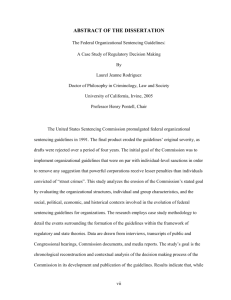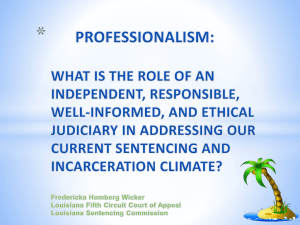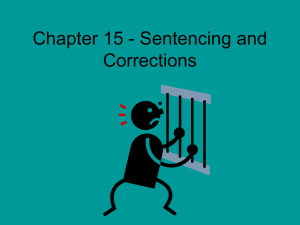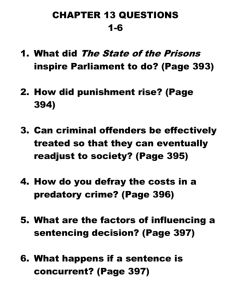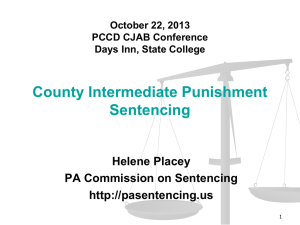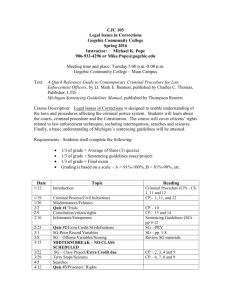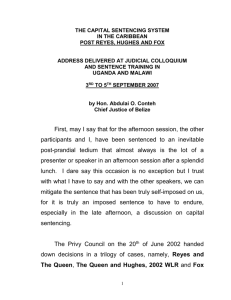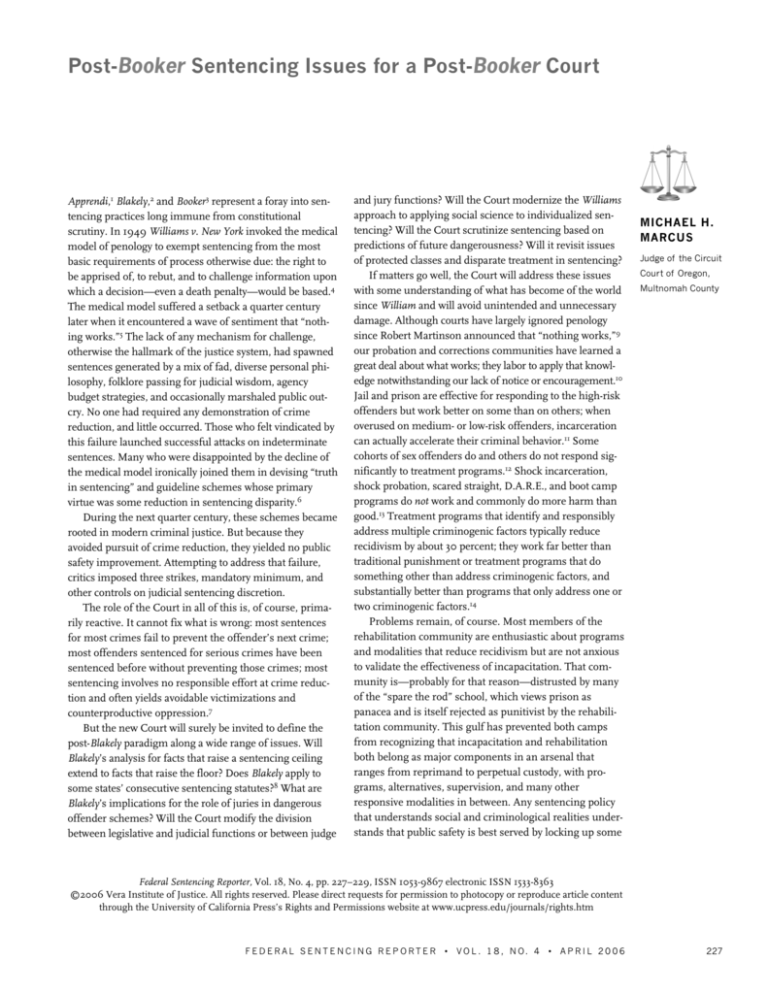
Post-Booker Sentencing Issues for a Post-Booker Court
Apprendi,1 Blakely,2 and Booker3 represent a foray into sentencing practices long immune from constitutional
scrutiny. In 1949 Williams v. New York invoked the medical
model of penology to exempt sentencing from the most
basic requirements of process otherwise due: the right to
be apprised of, to rebut, and to challenge information upon
which a decision—even a death penalty—would be based.4
The medical model suffered a setback a quarter century
later when it encountered a wave of sentiment that “nothing works.”5 The lack of any mechanism for challenge,
otherwise the hallmark of the justice system, had spawned
sentences generated by a mix of fad, diverse personal philosophy, folklore passing for judicial wisdom, agency
budget strategies, and occasionally marshaled public outcry. No one had required any demonstration of crime
reduction, and little occurred. Those who felt vindicated by
this failure launched successful attacks on indeterminate
sentences. Many who were disappointed by the decline of
the medical model ironically joined them in devising “truth
in sentencing” and guideline schemes whose primary
virtue was some reduction in sentencing disparity.6
During the next quarter century, these schemes became
rooted in modern criminal justice. But because they
avoided pursuit of crime reduction, they yielded no public
safety improvement. Attempting to address that failure,
critics imposed three strikes, mandatory minimum, and
other controls on judicial sentencing discretion.
The role of the Court in all of this is, of course, primarily reactive. It cannot fix what is wrong: most sentences
for most crimes fail to prevent the offender’s next crime;
most offenders sentenced for serious crimes have been
sentenced before without preventing those crimes; most
sentencing involves no responsible effort at crime reduction and often yields avoidable victimizations and
counterproductive oppression.7
But the new Court will surely be invited to define the
post-Blakely paradigm along a wide range of issues. Will
Blakely’s analysis for facts that raise a sentencing ceiling
extend to facts that raise the floor? Does Blakely apply to
some states’ consecutive sentencing statutes?8 What are
Blakely’s implications for the role of juries in dangerous
offender schemes? Will the Court modify the division
between legislative and judicial functions or between judge
and jury functions? Will the Court modernize the Williams
approach to applying social science to individualized sentencing? Will the Court scrutinize sentencing based on
predictions of future dangerousness? Will it revisit issues
of protected classes and disparate treatment in sentencing?
If matters go well, the Court will address these issues
with some understanding of what has become of the world
since William and will avoid unintended and unnecessary
damage. Although courts have largely ignored penology
since Robert Martinson announced that “nothing works,”9
our probation and corrections communities have learned a
great deal about what works; they labor to apply that knowledge notwithstanding our lack of notice or encouragement.10
Jail and prison are effective for responding to the high-risk
offenders but work better on some than on others; when
overused on medium- or low-risk offenders, incarceration
can actually accelerate their criminal behavior.11 Some
cohorts of sex offenders do and others do not respond significantly to treatment programs.12 Shock incarceration,
shock probation, scared straight, D.A.R.E., and boot camp
programs do not work and commonly do more harm than
good.13 Treatment programs that identify and responsibly
address multiple criminogenic factors typically reduce
recidivism by about 30 percent; they work far better than
traditional punishment or treatment programs that do
something other than address criminogenic factors, and
substantially better than programs that only address one or
two criminogenic factors.14
Problems remain, of course. Most members of the
rehabilitation community are enthusiastic about programs
and modalities that reduce recidivism but are not anxious
to validate the effectiveness of incapacitation. That community is—probably for that reason—distrusted by many
of the “spare the rod” school, which views prison as
panacea and is itself rejected as punitivist by the rehabilitation community. This gulf has prevented both camps
from recognizing that incapacitation and rehabilitation
both belong as major components in an arsenal that
ranges from reprimand to perpetual custody, with programs, alternatives, supervision, and many other
responsive modalities in between. Any sentencing policy
that understands social and criminological realities understands that public safety is best served by locking up some
MICHAEL H.
MARCUS
Judge of the Circuit
Court of Oregon,
Multnomah County
Federal Sentencing Reporter, Vol. 18, No. 4, pp. 227–229, ISSN 1053-9867 electronic ISSN 1533-8363
©2006 Vera Institute of Justice. All rights reserved. Please direct requests for permission to photocopy or reproduce article content
through the University of California Press’s Rights and Permissions website at www.ucpress.edu/journals/rights.htm
FEDERAL SENTENCING REPORTER
•
V O L . 1 8 , N O. 4
•
APRIL 2006
227
offenders and rehabilitating others, by aiming custodial
programs first at those inmates likely to benefit from
them, and by allocating resources according to proportionality, risk, harm reduction, and responsible exploitation of
the best information that we can muster to know which is
most appropriate for which offenders.
Forward-looking jurisdictions are beginning to emerge
from the poverty of a sentencing mission whose highest
goal is ordered just deserts. What will matter in the long
run about the new Court’s interaction with sentencing
schemes is whether the Court unintentionally or otherwise thwarts the transformation of sentencing from
archaic ritual to responsible pursuit of social health.
There is nothing about Blakely that threatens that transformation. Whether or not Blakely will apply to sentencing
floors as well as to ceilings, to dangerous offender schemes
or to some consecutive sentencing, juries are competent to
find such facts. The Blakely issue merely addresses when
the reasonable doubt standard and the right to a jury trial
apply to a fact relevant to the range of available sentences.
Attaching these accoutrements to a fact sacrifices nothing of
the potential for the best sentencing choice within whatever
range of discretion results from finding or not finding that
fact. The issue is no different than when the question is the
degree of robbery, theft, or homicide.
Nor is there any inherent risk to rational sentencing in
shifting the interface between court and jury decision making. Juries are fully capable of addressing evidence provided
to them, even scientific evidence, and the public safety track
record of judicial sentencing discretion hardly enhances our
claim to exclusive domain over sentencing choices. As
between legislative and judicial authority over sentencing,
judges are at least expected to exclude public clamor from a
role in decision making, but the Court has already gone so
far in accepting draconian sentencing schemes that this distinction is without much force. More importantly, we have
every opportunity to earn back lost judicial discretion by
accepting responsibility for the public safety outcomes of
sentencing choices within whatever discretion remains to
us and by demonstrating our ability to serve public safety.
To do that, of course, we need to open our process to modern criminology and to pursue smarter sentencing15
rigorously. That means we should invite advocates and probation departments to bring what criminologists are
learning to sentencing and probation hearings, and insist
that they also be prepared to discuss the practical considerations critical to the sentencing process.16 We also should
accept appropriate performance measures that include how
our sentencing choices play out in subsequent recidivism.17
A reexamination of Williams could substantially assist us
all. What’s right about Williams is that correctional and criminological information and thought is different than most
guilt-related evidence and should not be held to the same evidentiary thresholds. What is wrong about Williams is the
notion that a judge can make the best use of that evidence
without any meaningful engagement of the adversarial
process. Recognizing due process rights above the Williams
228
FEDERAL SENTENCING REPORTER
•
floor would not harm emerging sentencing practices or their
impact and might well enhance both. Surely, “process that is
due” plausibly includes notice to advocates of what information is under consideration and a meaningful opportunity to
rebuttal through evidence and argument.
Only one field of inquiry seems plausibly susceptible to
a catastrophic outcome—contentions that predicting
future dangerousness is unconstitutionally unfair, imperfect, or classification-based.18 Were the new Court to
agree, criminal justice would remain trapped in archaic
dysfunction for another generation. Sentencing judges, of
course, commonly consider future dangerousness in a
multitude of sentencing and release decisions, and no sentencing culture at all responsible to public safety could
function without that consideration. Ironically, the issue
would only arise when we consider future dangerousness
expressly and attempt to involve risk assessment, expert
opinion, and other tools in lieu of folklore, fad, and hubris.
Advocates of a purely retributive criminal justice system
and a minority of proponents of a pure treatment model
ironically unite in urging us to eschew science. Business
and government use equivalent science in functions as
important as budget and finance forecasting, pricing
insurance policies, and the allocation of flu shots. Yet
those who prefer morality play to crime reduction insist
that it is unconstitutional to recognize that offenders with
psychopathy or other actuarial indicators of risk for violent
recidivism should have a better chance of imprisonment.
Whatever may be necessary to find neutral alternatives
to protective class membership while assessing risk, and
even if supervening values require us on occasion to
ignore some otherwise relevant variable such as ethnicity,
we must be allowed responsibly to allocate resources
based on risk. That in turn requires best efforts at predicting future dangerousness. The alternative—the present
dance of ordered just deserts—is far less fair to victims,
offenders, and society as a whole and is often itself driven
by covert prediction and untested classifications.19 Commendably, Virginia20 and Missouri21 have incorporated
risk assessment into their guideline schemes, and Oregon
is considering doing so.22
The new Court may well increase rights along the continuum between establishing eligibility for a maximum
punishment (through guilt and sentencing enhancement
facts) and the wide discretion available for deciding what
sentence to impose subject to that maximum. What
process is due does and should vary along that continuum.
Ensuring that both sides have notice and an opportunity
for meaningful advocacy should help rather than hinder
the emergence of responsible sentencing, particularly if
we are able to get the same attention to science from criminal attorneys as we get from personal injury and products
liability practitioners. But it is essential that the Court continue to recognize that once an offender is convicted and
any sentencing enhancement facts are decided, it is a risk
of harm that we are managing, and that there is no constitutional impediment short of disproportionality or
V O L . 1 8 , N O. 4
•
APRIL 2006
protected class discrimination to allocating our devices for
harm reduction based on our best estimate of that risk.
13
Notes
1
2
3
4
5
6
7
8
9
10
11
12
14
For further information, see
http://www.smartsentencing.com.
Apprendi v. New Jersey, 530 U.S. 466 (2000).
Blakely v. Washington, 542 U.S. 296 (2004).
United States v. Booker, 543 U.S. 220 (2005).
Williams v. New York, 337 U.S. 241 (1949).
Robert Martinson is generally charged with suggesting in
1974 that nothing works. Martinson himself retreated from
this position, and it has been thoroughly debunked—at least
as applied to the offender population as a whole. See, e.g.,
JAMES MCGUIRE, WHAT WORKS IN REDUCING CRIMINALITY (2000),
and authorities cited at http://www.aic.gov.au/conferences/
criminality/mcguire.pdf.
Richard S. Frase, Sentencing Guidelines in Minnesota, 19782003, in 32 CRIME AND JUSTICE: A REVIEW OF RESEARCH 131-219
(Michael Tonry, ed. 2005); Richard S. Frase, Sentencing
Guidelines in Minnesota, Other States, and the Federal Courts: A
Twenty-Year Retrospective, 12 FED. SENT. REP. 69 (1999); KATE
STITH & JOSÉ A. CABRANES, FEAR OF JUDGING: SENTENCING GUIDELINES IN THE FEDERAL COURTS (1998); Michael Marcus, Justitia’s
Bandage: Blind Sentencing, 1 INT’L J. PUNISHMENT & SENT. 1
(2005); Kevin R. Reitz, Reporter, MODEL PENAL CODE: SENTENCING REPORT 28-29 (American Law Institute, Apr. 11, 2003).
Michael Marcus, Archaic Sentencing Liturgy Sacrifices Public
Safety: What’s Wrong and How We Can Fix It, 16 FED .SENT. REP.
76 (2003); Michael Marcus, Comments on the Model Penal
Code: Sentencing Preliminary Draft No. 1, 30 AM. J. CRIM. L.
135 (2003) [hereinafter Marcus, Comments on the Model
Penal Code]; Michael Marcus, Sentencing in the Temple of
Denunciation: Criminal Justice’s Weakest Link, 1 OHIO STATE J.
CRIM. L. 671 (2004).
Oregon, for example, forbids consecutive sentences for “separate convictions arising out of a continuous and
uninterrupted course of conduct” absent specific findings.
ORS 137.123.
Robert Martinson, What Works?—Questions and Answers about
Prison Reform, 25 THE PUBLIC INTEREST 25 (1974).
See generally Lawrence W. Sherman et al., National Institute
of Justice, Preventing Crime: What Works, What Doesn’t, What’s
Promising, Research in Brief (July 1998), and sources cited,
available at http://www.ncjrs.org/pdffiles/171676.pdf; the
full report is at http://www.ncjrs.org/works/wholedoc.htm;
Michael H. Marcus, Sentencing Support Tools and Probation in
Multnomah County, EXECUTIVE EXCHANGE (Spring 2004), available at http://www.smartsentencing.com under “Articles on
Smart Sentencing”; Elyse Clawson, Brad Bogue, & Lore
Joplin, Implementing Evidence-based Practices in Corrections
(National Institute of Corrections 2005), available at
http://www.nicic.org/Misc/URLShell.aspx?SRC=Catalog&RE
FF=http://nicic.org/Library/020174&ID=020174&TYPE=PD
F&URL=http://www.nicic.org/pubs/2004/020174.pdf.
The Effectiveness of Community-Based Sanctions in Reducing
Recidivism (Oregon Department of Corrections Sept. 5, 2002),
and authorities cited, available at http://egov.oregon.gov/
DOC/TRANS/CC/docs/pdf/effectiveness_of_sanctions_
version2.pdf.
See generally Recidivism of Sex Offenders, Center for Sex
Offender Management (Office of Justice Programs, U.S.
Department of Justice) (May 2001), and authorities cited,
available at http://www.csom.org/pubs/recidsexof.html;
Office of the Solicitor General of Canada, The Effectiveness of
15
16
17
18
19
20
21
22
Treatment for Sexual Offenders, 7(4) RESEARCH SUMMARY (July
2002), and sources cited, available at http://www.sgc.gc.ca/
publications/corrections/200207_e.asp.
Sherman et al., supra note 10.
See generally National Mental Health Association, Treatment
Works for Youth in the Juvenile Justice System (2006), and
sources cited, available at http://www.nmha.org/children/
justjuv/treatment.cfm; Mark Gornik, U.S. Department of Justice, National Institute of Corrections, Moving from
Correctional Program to Correctional Strategy: Using Proven
Practices to Change Criminal Behavior, and sources cited,
available at http://www.nicic.org/pubs/2001/017624.pdf.
Gornik’s meta-analysis of 154 studies found a 30% impact
on recidivism for the 54 studies that assessed responsibly
targeted and delivered treatment strategies.
“Smart sentencing” is sentencing, whether or not innovative,
that exploits information and reasoning to achieve a disposition that is most likely to accomplish the desired result—most
commonly, preventing the offender who is sentenced from reoffending. See http://www.smartsentencing.com, “Frequently
Asked Questions.”
Oregon has an online Criminal Benchbook that includes
some 24 pages (presently 727-751) on practical sentencing
considerations. It is available at http://www.ojd.state.or.us/
osca/cpsd/documents/CrimLawBenchBook_051230_
printable.pdf. In 1997 the Oregon Judicial Department
adopted a resolution that concludes, in part, “judges should
consider and invite advocates to address the likely impact of
the choices available to the judge in reducing future criminal
conduct.” See Legislative, Judicial, and Criminal Justice Commission Materials, available at http://www.smartsentencing.com.
The court performance measure movement generally promotes measures like time to trial and juror satisfaction, rather
than impact on public safety. See National Center for State
Courts, CourTools: A Court Performance Framework, available at
http://www.ncsconline.org/D_Research/CourTools/
CourToolsWhitePages-v4.pdf. Oregon has included recidivism
related to juvenile drug courts and will consider recidivism
performance measures more broadly in the near future.
Characteristic of this strain of thought are Noval Morris &
Marc Miller, Predictions of Dangerousness, in 6 CRIME AND JUSTICE: AN ANNUAL REVIEW OF RESEARCH 1-50 (Michael Tonry &
Norval Morris, eds. 1985) and ALLAN MANSON, SENTENCING AND
PENAL POLICY IN CANADA (Toronto: Emond Montgomery, 2000).
See Marcus, Comments on the Model Penal Code, supra note
7, at 146-47.
Virginia Criminal Sentencing Commission, Assessing Risk among
Sex Offenders in Virginia (Richmond: Virginia State Sentencing
Commission, 2001), available at http://www.vcsc.state.va.us/
sex_off_report; Brian J. Ostrom et al., Offender Risk Assessment in Virginia: A Three-Stage Evaluation (Williamsburg, VA:
National Center for State Courts, 2002), available at
http://www.vcsc.state.va.us/risk_off_rpt.pdf.pdf; Virginia
Criminal Sentencing Commission, 2004 Annual Report (Richmond: Virginia State Sentencing Commission, 2004),
available at http://www.vcsc.state.va.us/risk_off_rpt.pdf.
See Missouri Sentencing Advisory Commission, Automated
Recommended Sentencing Information, available at
http://168.166.76.135/RSWeb/message.do?r_Command=view.
See 2005 Oregon Laws, chapter 474 (2005 Or SB 919), available at http://www.leg.state.or.us/05reg/measpdf/sb0900.dir/
sb0919.en.pdf, which directs the Oregon Criminal Justice Commission to “conduct a study to determine whether it is possible
to incorporate consideration of reducing criminal conduct and
the crime rate into the commission’s sentencing guidelines.” To
date, the major focus is risk assessment.
F E D E R A L S E N T E N C I N G R E P O RT E R • V O L . 1 8 , N O. 4 • A P R I L 2 0 0 6
229

